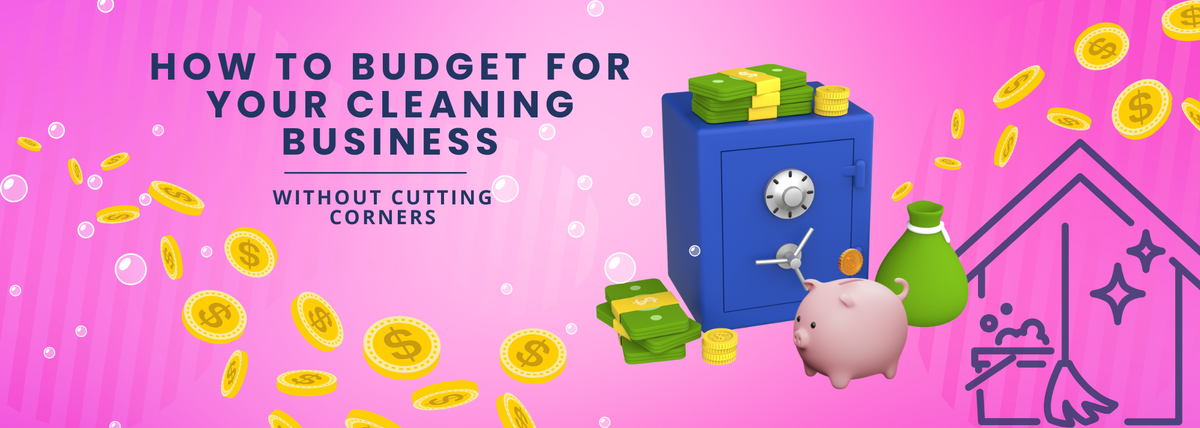How to Budget for Your Cleaning Business Without Cutting Corners

Running a cleaning business requires a delicate balance between providing high-quality service and maintaining a profitable operation. Budgeting is at the heart of this balance. Done correctly, it ensures you can meet client expectations without compromising your financial stability or cutting corners.
In this blog, we’ll walk you through creating a budget that supports your goals while maintaining the professional standards your clients expect.
1. Understand Your Fixed and Variable Expenses
Every successful budget begins with understanding where your money is going. Expenses in a cleaning business typically fall into two categories:
- Fixed Expenses: These are costs that remain consistent, such as:
- Office rent or utilities (if applicable)
- Insurance (liability, worker’s compensation)
- Equipment costs (vacuum cleaners, mops, etc.)
- Marketing subscriptions or website hosting
- Variable Expenses: These fluctuate based on the volume of work or other factors. Examples include:
- Cleaning supplies
- Transportation or fuel costs
- Temporary labor for larger jobs

Start by listing all your expenses and categorizing them. This gives you a clear picture of your financial obligations and helps identify areas for potential savings.
2. Set Clear Income Goals
Your budget should align with your income goals. Ask yourself:
- How much revenue do I need to cover my expenses?
- What’s my target monthly profit?
- Do I want to expand, hire more staff, or purchase new equipment soon?

Use these questions to set realistic revenue and savings goals. For instance, if you aim to grow your business, allocate a percentage of your earnings to a growth fund.
3. Prioritize Essential Expenses
It can be tempting to cut costs, but it’s crucial to avoid doing so at the expense of quality. Your reputation depends on delivering consistent results. Prioritize investments that directly impact your service, such as:
- High-quality cleaning supplies: Eco-friendly or professional-grade products are worth the investment and appeal to more clients.
- Reliable tools and equipment: Breakdowns can cost you more in lost time and repairs than upfront investment in durable equipment.
- Employee training: Skilled workers are efficient and less likely to make costly mistakes.

4. Plan for Seasonal Fluctuations
Many cleaning businesses experience seasonal highs and lows. For instance, demand may spike during spring cleaning or the holiday season and drop in slower months. Planning for these fluctuations ensures you can cover your expenses year-round.
- Save during peak months to offset slower periods.
- Offer promotions or diversify services during slower times to attract clients (e.g., organizing services or post-renovation clean-ups).

5. Track and Analyze Your Spending
It’s easy to lose track of small expenses that add up over time. Use accounting software or budgeting tools to monitor every dollar spent. Regularly review your financial reports to spot trends, unnecessary spending, or areas where you could improve efficiency.
Some tools specifically tailored for small businesses include:
- QuickBooks: For detailed expense tracking and financial insights.
- Wave: A free option for invoicing and expense management.

6. Negotiate with Suppliers
Don’t hesitate to shop around for better deals on supplies or services. Reach out to vendors and ask about bulk discounts or loyalty programs. Even small savings on frequently used items can add up over time.
7. Automate Administrative Tasks
Administrative tasks, like invoicing and scheduling, can consume valuable time. Automating these tasks reduces administrative costs and allows you to focus on serving clients.
Consider using tools to streamline operations:
- Scheduling Software: Tools like Jobber or Launch27 can help manage bookings efficiently.
- Invoicing Platforms: Automate billing and payment reminders to reduce late payments and save time.

8. Budget for Marketing
Marketing is an essential part of growing your cleaning business. Allocate a percentage of your revenue to marketing efforts that deliver results.
Cost-effective marketing strategies include:
- Building a strong social media presence (with free tools like Canva for designing posts).
- Encouraging client referrals by offering discounts or rewards.
- Creating and maintaining a professional website to attract online leads.

9. Save for Emergencies
Unexpected expenses, like equipment repairs or emergency clean-ups, can throw off your budget if you’re unprepared. Aim to save at least 10% of your monthly income for an emergency fund to cover these surprises without stress.
10. Reevaluate Regularly
Your business will grow and change, so your budget should too. Schedule a quarterly review to assess whether your expenses align with your goals. Adjust your budget as needed to ensure it remains effective and realistic.

In closing, budgeting for your cleaning business doesn’t have to mean cutting corners. By prioritizing essential expenses, planning for the unexpected, and tracking your spending, you can build a budget that supports both your professional standards and financial goals.




